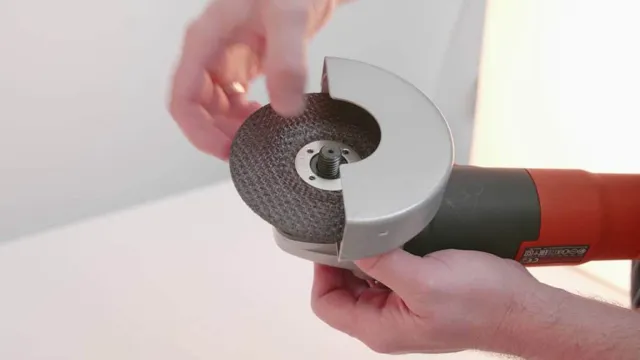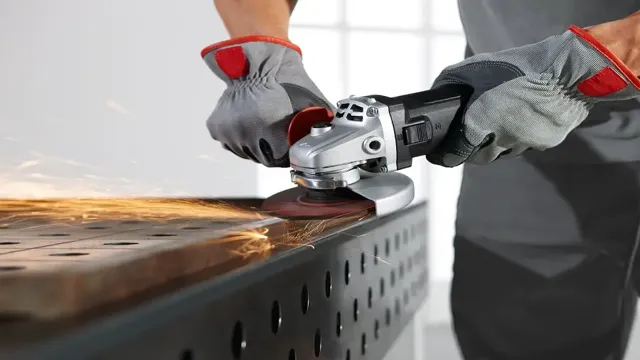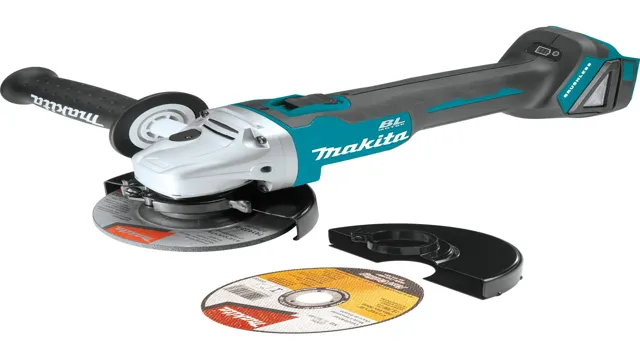Can You Use Angle Grinder to Cut Metal Efficiently? Tips to Follow.
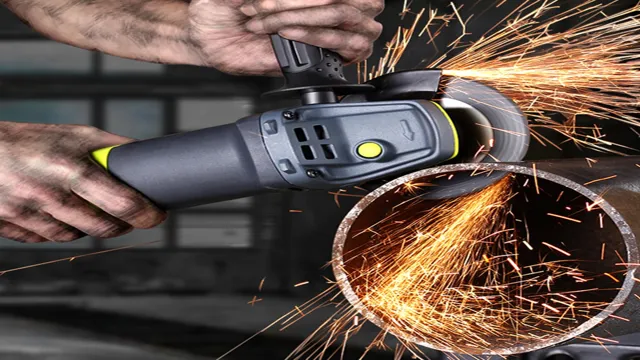
If you’re looking for a versatile tool to make fast and precise cuts on metal, then an angle grinder is a perfect fit. Angle grinders are handheld power tools that use a spinning abrasive wheel or disc to grind, cut, and polish various materials such as metal, stone, and concrete. Cutting metal is the most common use of angle grinders.
The question is, can you use an angle grinder to cut metal? The simple answer is yes, you definitely can. But it’s crucial to take all the necessary precautions when cutting metal with an angle grinder as it involves high-speed spinning discs that could lead to injury if used carelessly. In this blog post, we’ll dive deep into the world of angle grinders and explore how you can safely and efficiently use them to cut metal.
Understanding Angle Grinders and their Uses
Angle grinders are incredibly versatile tools that can be used for a variety of tasks, including cutting metal. They are powered by an electric motor with a rotating disc, which can be fitted with various attachments depending on the task at hand. However, it’s essential to keep in mind that not all angle grinder blades are created equal, and some are designed specifically for metal cutting.
Whether you’re a professional welder or a hobbyist DIY enthusiast, having the right blade for the job is crucial. When cutting metal with an angle grinder, it’s vital to wear protective gear, including safety glasses, gloves, and a respirator, as well as ensuring that the workpiece is firmly secured. By using the proper safety gear and following the correct procedures, you can effectively use an angle grinder to cut metal and achieve professional results.
What is an Angle Grinder?
An angle grinder is a versatile tool commonly used in construction, metalworking, and woodworking. The machine is named due to the angle of the abrasive disc attached to it, which can vary from 4 inches to 12 inches. Angle grinders come equipped with different kinds of discs or wheels, depending on the type of work they are intended for, such as cutting, grinding, sanding, polishing, and even wire-brushing.
It is an electric-powered tool that allows for handheld operation and requires a power source, either a cord plugged into an outlet or a battery. Angle grinders can be operated with one hand, providing flexibility in confined spaces and quick work on various materials. However, caution must be exercised when using these machines due to their high speed and potential kickback.
Always follow safety guidelines and manufacturer recommendations to avoid accidents.
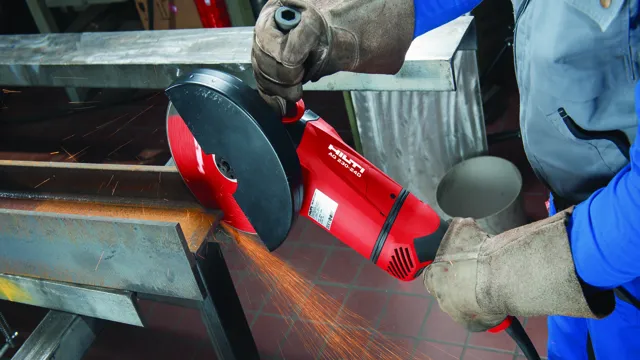
Types of Angle Grinders
Angle grinders are versatile power tools used for various cutting, grinding, and polishing tasks in DIY projects and professional construction sites. There are different types of angle grinders available in the market, including corded and cordless models, with multiple disc sizes and power ratings. These tools range from small, compact designs for home use to heavy-duty, industrial-grade models for commercial applications.
When selecting an angle grinder, it is crucial to consider factors such as ease of use, durability, power, and safety features. Some popular types of angle grinders are safety grinder, disk grinder, and compact angle grinder, each with its unique features and uses. Safety grinders have fully enclosed housing, and the grip handles are far apart, making them safer for users.
Disk grinders come with large grinding wheels for heavy-duty tasks, while compact angle grinders are smaller and more maneuverable, making them ideal for tight spaces and detailed jobs. Whatever your application, there is an angle grinder suitable for your needs.
Cutting Metal with an Angle Grinder
Yes, an angle grinder is often used for cutting metal, and it can be a highly effective tool if used properly. An angle grinder operates by rotating a wheel with abrasive edges at high speeds, which allows it to cut through metal quickly and efficiently. However, it is important to note that an angle grinder can be dangerous if not used with caution.
Proper safety gear such as eye protection and gloves should always be worn when using an angle grinder. Additionally, it is important to use the correct type of cutting wheel for the specific type of metal being cut and to make sure the blade is securely attached before beginning the cutting process. With these precautions in place, an angle grinder can be a valuable tool for cutting metal in a variety of situations.
Steps for Cutting Metal with an Angle Grinder
Cutting metal with an angle grinder is a process that requires some basic steps and precautions to be taken to ensure safety. To begin with, you need to make sure that you have the appropriate disc for the job, that is a disc designed specifically for cutting metal. Once you have the right disc, you need to make sure that it is firmly secured to your angle grinder before beginning.
This is important, as a loose disc can cause accidents that result in serious injuries. It is also important to confirm that the blade’s rotation is moving in the same direction as the arrow on the disc. The next step is to set the angle grinder to the desired speed, and make sure that the safety guard is in place to protect you from any sparks generated during the cutting process.
Finally, you need to position the metal piece on a stable surface, hold the angle grinder with both hands, and slowly begin cutting the metal. Remember to let the angle grinder work for itself (don’t push down too hard) and make sure to wear protective clothing and eyewear. By following these basic steps, you will be able to cut metal with an angle grinder safely and effectively.
Safety Precautions to Take When Using Angle Grinders
When cutting metal with an angle grinder, it is important to prioritize safety precautions. Firstly, wearing protective gear is a must – gloves, safety glasses, and even a face shield to prevent sparks from flying into your face. It’s also essential to secure the metal you are cutting in a clamp or vise to prevent slips and wobbling.
It’s important to check that the grinder’s blade is well tightened before using it. Angle grinders can produce a lot of dust that can cause harm, so use a dust mask or respirator to protect your lungs. Always avoid using an angle grinder near flammable substances or gas lines.
And when you’re done cutting, make sure the grinder is unplugged and blades are stored safely away from children or pets. Best practice involves taking breaks to avoid fatigue and keeping the grinder lubricated to prevent overheating. By following these safety precautions, cutting metal with an angle grinder can be efficient and safe.
Factors to Consider When Choosing an Angle Grinder for Cutting Metal
Angle Grinder for Cutting Metal When it comes to cutting metal with an angle grinder, there are several factors to consider before making a purchase. The first consideration should be the size of the angle grinder. You don’t want to use a small, handheld grinder for larger metal cutting tasks.
A larger grinder will provide more power and make cuts smoother and more precise. The next consideration is the type of metal you will be cutting. Different metals require different types of cutting wheels.
For example, a wheel suitable for cutting mild steel may not be able to cut through stainless steel or aluminum. The thickness of the metal is also important to consider. Thicker metals require more power and a larger cutting wheel.
Additionally, the speed of the grinder is important. If the speed is too high, it can cause the wheel to overheat and potentially break. Finally, safety should always be a top priority.
Make sure to wear safety glasses, gloves, and a face mask to protect yourself from metal sparks and dust. Overall, choosing the right angle grinder for cutting metal is essential to achieving the desired results safely and efficiently.
Alternatives to Angle Grinders for Cutting Metal
Can you use an angle grinder to cut metal? Yes, you absolutely can. However, if you’re looking for alternatives, there are several options available. One option is using a metal cutting saw, which produces less sparks and creates a cleaner cut without the risk of breaking or chipping the blade.
Another option is using a plasma cutter, which is extremely precise and can cut through thick metal easily. If you don’t have these tools available, a hacksaw can also be used, although it requires more effort and time. Whichever method you choose, make sure to take proper safety precautions, such as wearing eye and ear protection, gloves, and a respirator, and ensuring that the area is well-ventilated.
Metal Cutting Saw
When it comes to cutting metal, the go-to tool for many people is the angle grinder. However, there are some alternatives that can be just as effective and perhaps even safer. One such tool is the metal cutting saw.
This type of saw is specifically designed for cutting through metal, and it does so with precision and ease. Unlike angle grinders, metal cutting saws produce less heat and sparks, making them a safer option. They also produce smoother cuts, which can be especially important if you’re working on a project that requires a high level of precision.
So the next time you’re in need of a tool to cut metal, consider using a metal cutting saw as an alternative to the trusty angle grinder.
Plasma Cutter
When it comes to cutting metal, most people immediately think of angle grinders. However, there are several alternatives to this common tool, including the plasma cutter. Plasma cutters are a highly precise tool that uses an electrically conductive gas to transfer energy to a conductive metal, creating a high-temperature plasma arc that cuts through the metal.
This process allows for faster and more accurate cuts, making it an excellent option for those looking to cut metal on a regular basis. Additionally, plasma cutters produce less heat compared to angle grinders, which means there is less risk of warping or damaging the metal. Overall, if you’re in the market for a tool that can cut metal with precision, a plasma cutter is an excellent alternative to the traditional angle grinder.
Conclusion
Yes, using an angle grinder to cut metal is possible and practical, but just like any tool, it requires caution, patience, and the right technique to avoid injury or damage. So, grab your safety gear, focus on the task, and don’t be afraid to unleash the sharpness of your angle grinder on your metal workpieces. Who knows, you might even create a masterpiece that cuts through the competition!”
FAQs
What safety precautions should I take while using an angle grinder to cut metal?
You should wear protective gear, secure the workpiece, and ensure that the grinder is properly grounded.
What type of blade or disc should I use with my angle grinder to cut metal?
A metal cutting blade or abrasive disc is recommended for cutting metal with an angle grinder.
Can I use an angle grinder to cut through thick metal?
Yes, an angle grinder with a powerful motor and a suitable disc can cut through thick metal.
How do I ensure accurate cuts while using an angle grinder to cut metal?
You can use a guide or a fence to keep the grinder on track and achieve accurate cuts.
Can I use an angle grinder to cut other materials besides metal?
Yes, an angle grinder can be used to cut various materials such as tiles, masonry, and concrete.
How do I maintain my angle grinder to ensure longevity and optimal performance?
You should clean the tool after use, check and replace worn parts, and store it properly.
What are some common mistakes to avoid when using an angle grinder to cut metal?
Some common mistakes include using the wrong blade or disc, applying excessive pressure, and wearing improper protective gear.
